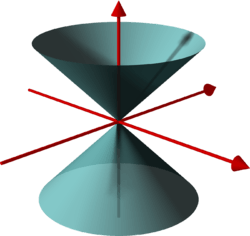Conical surface

In geometry, a (general) conical surface is the unbounded surface formed by the union of all the straight lines that pass through a fixed point — the apex or vertex — and any point of some fixed space curve — the directrix — that does not contain the apex. Each of those lines is called a generatrix of the surface.
Every conic surface is ruled and developable. In general, a conical surface consists of two congruent unbounded halves joined by the apex. Each half is called a nappe, and is the union of all the rays that start at the apex and pass through a point of some fixed space curve. (In some cases, however, the two nappes may intersect, or even coincide with the full surface.) Sometimes the term "conical surface" is used to mean just one nappe.
If the directrix is a circle  , and the apex is located on the circle's axis (the line that contains the center of
, and the apex is located on the circle's axis (the line that contains the center of  and is perpendicular to its plane), one obtains the right circular conical surface. This special case is often called a cone, because it is one of the two distinct surfaces that bound the geometric solid of that name. This geometric object can also be described as the set of all points swept by a line that intercepts the axis and rotates around it; or the union of all lines that intersect the axis at a fixed point
and is perpendicular to its plane), one obtains the right circular conical surface. This special case is often called a cone, because it is one of the two distinct surfaces that bound the geometric solid of that name. This geometric object can also be described as the set of all points swept by a line that intercepts the axis and rotates around it; or the union of all lines that intersect the axis at a fixed point  and at a fixed angle
and at a fixed angle  . The aperture of the cone is the angle
. The aperture of the cone is the angle  .
.
More generally, when the directrix  is an ellipse, or any conic section, and the apex is an arbitrary point not on the plane of
is an ellipse, or any conic section, and the apex is an arbitrary point not on the plane of  , one obtains a conical quadric, which is a special case of a quadric surface.
, one obtains a conical quadric, which is a special case of a quadric surface.
A cylindrical surface can be viewed as a limiting case of a conical surface whose apex is moved off to infinity in a particular direction. Indeed, in projective geometry a cylindrical surface is just a special case of a conical surface.
Equations
A conical surface  can be described parametrically as
can be described parametrically as
 ,
,
where  is the apex and
is the apex and  is the directrix.
is the directrix.
A right circular conical surface of aperture  , whose axis is the
, whose axis is the  coordinate axis, and whose apex is the origin, it is described parametrically as
coordinate axis, and whose apex is the origin, it is described parametrically as
where  and
and  range over
range over  and
and  , respectively. In implicit form, the same surface is described by
, respectively. In implicit form, the same surface is described by  where
where
More generally, a right circular conical surface with apex at the origin, axis parallel to the vector  , and aperture
, and aperture  , is given by the implicit vector equation
, is given by the implicit vector equation  where
where
or
where  , and
, and  denotes the dot product.
denotes the dot product.
In three coordinates, x, y and z, the general equation for a cone with apex at origin is a homogenous equation of degree 2 given by




